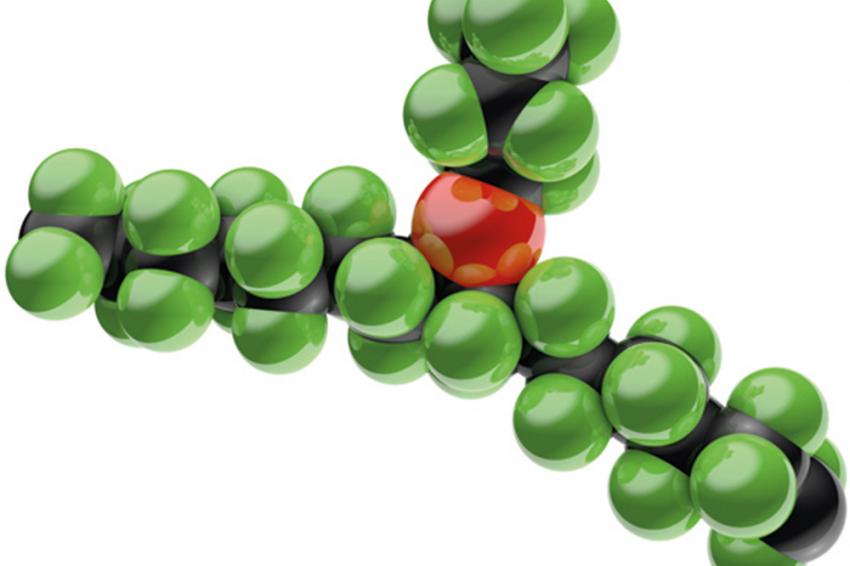Corrosion Protection
How the Chemical Industry Achieves the Goal with Various Materials
Fluoropolymer system solutions are increasingly used in chemical plants for corrosion-protection tasks. They usually offer considerable advantages over alternatives such as stainless steel, enamel-coated steel or glass in dealing with corrosion. Practice has shown, however, that the plant operator’s expectations could not always be completely fulfilled. Therefore, in this article, influencing factors such as the selection of the right materials, the application, the appropriate manufacturing methods or component design are analyzed in more detail in order to provide the designer and the operator of a chemical plant with additional information for a successful, durable plant design.
The chemically modified second-generation PTFE, 3M Dyneon TFM Modified PTFE, is a PTFE in which the molecular chains of the polymer have been chemically modified by perfluoropropylvinylether (PPVE), a similarly perfluorinated modifier. At the same time the molecular weight of this second-generation PTFE was lowered in order to significantly improve the particle fusion of this PTFE. It is being processed using press-sintering methods or paste extrusion.
If we consistently continue the polymer modification by lowering the molecular weight in combination with the incorporation of the co-monomer PPVE, then we obtain a perfluoroalkoxy polymer, better known under the name PFA. Thanks to the low molecular weight, the representatives of this product group can be processed using the common thermoplastic processing methods like extrusion or injection molding and thus significantly extend the product range of the perfluorinated polymers.
Whereas resistance lists are normally used with materials in connection with corrosive chemicals or solvents, this is not the case with PTFE, modified PTFE or PFA. These materials can be said to exhibit almost universal chemical resistance. Only a few critical exceptions have to be taken into consideration. Among these are fluorinated hydrocarbons; alkali metals; monomers such as styrene, butadiene or acrylonitrile; or, finally, high-energy radiation, which can destroy the polymer itself.
Constructive Measures Necessary Despite Special Property Profile
Against the background of their use in the corrosion protection, demands are made of fluoropolymers in particular with regard to their excellent chemical resistance, high temperature stability and very high barrier effect, i.e., low permeation rates in relation to the chemical mixtures that arise. Their good non-stick properties facilitate cleaning, even when CIP (cleaning in place) or SIP (sterilization in place) procedures are applied.
The aforementioned perfluorinated polymers fulfill all of these properties.
Despite the excellent barrier properties of modified PTFE and PFA, however, it must be considered that a not-inconsiderable permeation takes place, in particular at higher temperatures. The gaseous chemical components enter the polymer material on the side in contact with the product, cross through it, and exit the material again at the “rear side.” Since permeation increases strongly with temperature, the values were determined at 100°C for realism. Under these conditions TFM allows the lowest permeation, followed by PFA. The influence of the thickness of the barrier layer in the range between 1 and 3 mm also proves to be particularly significant. Therefore, linings should have a thickness of more than 2 mm if possible. Non-modified PTFE, which exhibits the highest permeation values, should therefore only be used conditionally as a barrier for corrosion protection in corrosive environments. However, standard PTFE also proves to be a good problem solver in full fluoropolymer constructions in which temperature and chemical resistance are demanded, but where the barrier properties can be classified as subordinate.
The barrier properties change at the different temperatures that occur in chemical plants. PFA exhibits the best barrier properties for hydrogen chloride gas up to temperatures of around 80°C (355 K); at higher temperatures modified PTFE proves to be the material with even lower permeation.
Especially at elevated temperatures, permeation cannot be entirely avoided. This must be considered to achieve the goal of a durable construction. When lining chemical reactors, columns, tanks and pipes with a film of modified PTFE or PFA according to the “loose shirt method,” i.e., fixing the liners by clamping between the flanges, care must be taken to ensure effective back ventilation. This ensures the removal of the gaseous corrosive substances diffusing in low amounts through the protective liner, and the dew point TD in the space between the liner and the wall of the duct is not reached: The system remains dry and therefore no corrosion can occur.
Systems Made Of Fluoropolymers
So which fully fluorinated products are used in chemical plants requiring corrosion protection? The table provides information on plant components for corrosion protection, the polymers that come into question and the polymer-specific production methods. The inclusion of the sintering material “standard or modified PTFE” on the one hand as well as the thermoplast-processible PFAs on the other hand enables the complete production of the required range of products.
The various options for polymer selection, the combination with the associated different processing methods, the presence of alternatives for most applications as well as the consideration of special design criteria for the layout of durable system solutions mean that a round-table discussion at the start of the project is an important component for success.
Closing the Cycle with End-Of-Life Products
Although corrosion protection systems based on fluoropolymers are usually durable system solutions, it may nevertheless be necessary because of the very aggressive conditions to partially or completely replace components and systems during inspections. Using the new Up-Cycling process developed by Dyneon, a subsidiary of the multitechnology company 3M, these waste products can now be split back into their raw components, the monomer tetrafluoroethylene (TFE). After purification, the TFE obtained is subsequently converted again into new fluoropolymers, which are no different from the original products in terms of their properties.
Contact
Dyneon GmbH
Carl-Schurz-Str. 1
41460 Neuss
Germany







